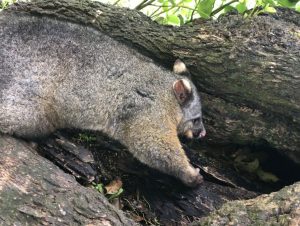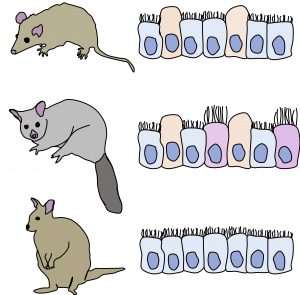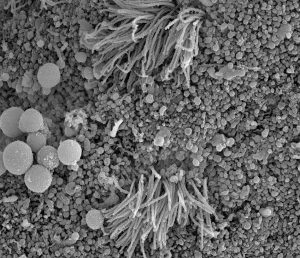Pest or Prize? – Melanie Laird explores Possum Pregnancy and Genetics
Paihamu (Brush Tail Possum)
The possum, at first glance, appears a pesky drab rodent. For kiwis, they are a reminder of the recklessness of early settlers’ preference for introducing game animals, over preserving our existing native wildlife. For Australians, they are an endemic animal of national significance, critically endangered, and far removed from their native habitats. Melanie Laird is doing fascinating research on an animal that everyone knows, but most people do not give much thought to, beyond whether it was big enough to dint your car upon becoming a roadkill victim.
Melanie explained that for various reasons possums, and marsupials in general, have not been studied anywhere near the amount of mammals. Being Australian herself, Melanie is well acquainted with marsupials and has worked with them for a long time. Melanie explained, “there are a lot of unanswered questions in that, marsupials are a very unusual, but very understudied group of animals, and it is often assumed that they are the same as other mammals, but they are actually quite different. I work on brushtail possums because they are such an important economic pest and environmental pest. There is a lot of national interest in studying them more, and in working out ways of getting rid of them. This is good news for us because it means there is more money around to go back and look at the basic aspects of their biology. There is a lot of stuff that people want to do with possums. And there are a lot of applied aspects of pest control could work with possums.”
Gene Drives
Advances in genetic engineering have brought up the concept of what is called a ‘gene drive’, for pest eradication. Melanie explained, “if you wanted to get rid of an animal population in New Zealand, you could introduce individuals into the population that have a particular genetic ‘edit’ that is heritable, and always gets passed on to offspring.” New technologies such as CRISPR-CAS9, provide a means of doing this. “With something like CRISPR CAS-9, instead of normal Mendelian inheritance (where half of the offspring have a particular gene, and the other half do not) the genetic change that you make will be passed on to 100% of offspring.” If for example, a gene edit is introduced to make all males infertile, all male offspring of the introduced animals will be infertile, and the females will be carriers of male infertility. Melanie explained “that would keep going through the generations. In a small population, it does not take very many individuals before you have got effective extinction, where all of the males are infertile. Then there are only females. It would not take very many individuals if the population was small to begin with. But in a big population, you would need a lot of transgenic individuals added. Otherwise, the effect would be diluted—the rate of breeding of everybody else would outpace the breeding of the ones that you added.”
Melanie’s current research, therefore, looks at marsupial birth and development, as this is an area with very little research. We cannot expect to produce viable pest control interventions for possums when very little is known about their development. Melanie explained how “people ask ‘should we do this?’, and ‘should we do that?’, but the truth of it is that we do not know enough about them to know what will work.” Melanie is doing the basic research required to answer the questions of whether things like gene drives would even be possible. “Technically we do not know if things like gene drives would be possible [for marsupials], or even gene editing. That is one of the big unanswered questions about the work that I do: can you make a genetically modified marsupial? We do not know that yet… the normal ways of doing this…that we do pretty routinely to make transgenic mice and rats have not worked thus far for marsupials.
Melanie offered some reasons why marsupials are a relatively understudied group of animals. “There are many ways in which the marsupial develops differently during pregnancy [compared to regular mammalian pregnancies]. The length of pregnancy is incredibly short. Marsupials have a lot of quirks that have made [studying their development] very difficult. That means that we cannot make a marsupial cell line, for example. We cannot make transgenic marsupials for any research, in any application. They are used widely for research, and a lot of universities have colonies of them for different things. But if for example, we want to find out what a gene does in a marsupial, we have to knock it out in a mouse, and then extrapolate. Even worse, if it is a novel marsupial gene, we have to put it into a mouse, and see what happens. It is really, not a good way of figuring that out.”
Melanie’s Path to Possums
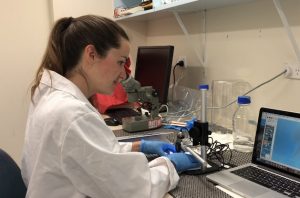 Melanie hails from the central coast of New South Wales originally. She recalls that as a child “all I wanted to be when I grew up was whatever David Attenborough was. I was obsessed with bugs and plants and everything—I loved natural history. When I went to university, I did a science degree and completely fell in love with invertebrate and vertebrate anatomy, because that was about as close as I could find to being David Attenborough in a class, and I loved it.” When considering projects for her honour’s year, Melanie explained she had the opportunity to work with fat tail dannarts, an Australian marsupial. For her PhD, she explained, “I did a broad comparative study with Brushtail Possums and Tamar Wallabies, among different kinds of things, trying to understand the molecular changes (not genetics at that stage) that a marsupial uterus has to undergo to support a marsupial pregnancy.”
Melanie hails from the central coast of New South Wales originally. She recalls that as a child “all I wanted to be when I grew up was whatever David Attenborough was. I was obsessed with bugs and plants and everything—I loved natural history. When I went to university, I did a science degree and completely fell in love with invertebrate and vertebrate anatomy, because that was about as close as I could find to being David Attenborough in a class, and I loved it.” When considering projects for her honour’s year, Melanie explained she had the opportunity to work with fat tail dannarts, an Australian marsupial. For her PhD, she explained, “I did a broad comparative study with Brushtail Possums and Tamar Wallabies, among different kinds of things, trying to understand the molecular changes (not genetics at that stage) that a marsupial uterus has to undergo to support a marsupial pregnancy.”
“I fell in love with marsupials doing that work, because they were fascinating, and I realised that even as an Australian, I knew very little about them, and other people did not appreciate them at all. When I finished my PhD, I saw that a job was going here to continue to work on marsupial biology. Not for the reason of understanding, protecting, or conserving them, but for getting rid of them.” This was fine with her, as any research into marsupials would be beneficial to them as a whole.
Melanie now works on the development of brushtail possum joeys. “We are interested in understanding how the germ cells (that go on to either: become the eggs; or the producers of sperm in an adult’s gonads) actually develop to that point, and what epigenetic changes have to occur to those cells…Immature germ cells start out with a set ‘pattern of methylation’. Very early in development, they completely lose their methylation. They then regain it again in such a way that the methylation pattern reflects the sex that the Joey will be. There will be female-related patterns or male-related patterns. If we want to do things with these cells or compare them for some other aspect, then we need to be aware of what differences in methylation there might be…The cells are undergoing an important process at the time when we think that they could be most easily edited or modified. We think this might be useful for gene editing. Even a week or two after the young is born, the immature sex cells still possess stem cell like characteristics. We could potentially use them in place of the embryonic stem cells that other techniques use to try to introduce a genetic change, we think.”
Obstacles to Overcome
Gene drives are a new concept and have not been tried on a large scale yet. There is potential for unintended side effects, as with any new technology. The biggest risk with a possum gene drive is that it could be too effective, and potentially put Australian possums at risk of extinction, as they are genetically identical to New Zealand possums. Scientists are all too aware of this risk and aware of the fact that robust safeguards and umpteen safety measures must be in place, in order to try something like this. I asked Melanie what she thinks the key reasons people might have trouble understanding new technologies like this are.
“It is a gut reaction in a lot of cases. However, because it is a theoretical concept, we as scientists do not have a good answer for this, the real issue is once you release a gene drive, how do you stop a gene drive? The best answer that we have, which is a terrible answer, is to produce another gene drive. That is not good enough. That is not fixing the problem. That is the problem with these technologies, especially in the minds of the public, but also a scientist’s concern too: once you open the box, you cannot close it. Saying yes to something is saying yes to basically everything. That is what it seems like. And there is a lot of concern, it is quite touching really as an Australian—one of the main things people say is, what about Australian possums? And I am like, oh you actually care about them, that is nice. In terms of the biosecurity laws and regulations, there is nothing in place yet for this, because it does not exist. The likelihood of something like that happening—of gene-edited possums with reduced fertility or whatever, ending up in Australia, and destroying the Australian population—is incredibly low. But if it did happen, the consequences could be unbelievably bad. At the moment, it is a risk we cannot take until we know that there is a way of stopping it, or mitigating it, or diluting it, or protecting Australian individuals in some other way. I think that is the main concern, you cannot do anything about it once you start that journey.”
In New Zealand, we are all too aware of the unintended consequences of large-scale conservation interventions. Mistakes were made by early colonists who introduced small rodents for sport, and then small carnivores to control the populations of those rodents when they became out of control. Melanie explained “we remember that stuff, and we know that that does not work. Unless there is a good way to stop it, then people are not likely to be on board.” This is a technology that could provide a viable solution to remedying the mistakes made by early settlers, and as such there can be no risk of making those same mistakes.
In terms of genetic engineering for the purposes of gene editing, Melanie commented “Pest control is a grey area I think, where a lot of people are very against it, and I can completely understand why. But a lot of people are starting to think that what we are doing now is not the best, but we do not have any other alternatives. We should be at least investigating these other ideas.”
Ultimately, the success of this project will depend on the public’s trust in scientists.
“The reason that it has been such a rocky road for gene editing in New Zealand is that originally it was done in a way without any consultation with the public. Pretty much without the public’s awareness, and that does not look good—that you are behind closed doors doing this mad scientist thing. The public needs to be aware of all of this. It does not work if it is not transparent and open and flexible. I think scientists doing things in that way and expecting it to be fine is paternalistic in a way. It is saying that we as scientists know what you need, and we understand your needs better than you do, and we are more intelligent, and you should listen to what we have to say. That is very arrogant, but it is an easy identity to put on as a scientist. Things are a lot different now, but I think that that stuff leads to a real distrust of science and scientists, and what their agenda is.”
I can completely understand people who are against it. Generally, it does not matter how much awareness there is, or how many facts you tell them about gene editing. I think the only thing that is going to change that, is if people who are against a technology understand that the people who are developing the technology, really do have their best interests at heart. Scientists are not going to assume those interests, they are going to actually ask what is needed, and they are going to do it in the safest way. They are not in it to discover something amazing at the expense of whatever, they are actually doing it because they are trying to benefit society, in the way that society wants to be benefitted, I would say that the attitudes have changed and that the awareness has increased, but what it is going to take is scientists being visible people and being open and transparent about what they are doing, and making sure that what they are doing is actually what is wanted and needed by society. It needs to be done in a way that is not unnecessarily risky, which is hard. But I think that we should all try to do that.”
Gene Drive in New Zealand?
I asked Melanie if she could give a general idea of the risk of total possum extinction, including an unintended consequence of wiping out Australian possums as well. “I would say that it would be low, but that we do not fully understand. It would depend on what was different about these newly introduced possums. If they were released into Australia, in an area with a small population, then the effect could be enormous. Possums are protected in Australia, and in the natural areas where they are supposed to be, their habitat has been threatened to an extent that the populations are in little fragments. You could effectively, with not very many individuals, cause a lot of damage. I do not know how many you would need, or how many could be transferred to Australia. I do not know what the likelihood of any of that is. But it is not inconceivable that a relatively small amount could do a lot of damage in an Australian population.”
Melanie and I discussed the regulations for animal studies and genetic studies in New Zealand, and whether they are appropriate. Melanie’s comprehensive understanding of the ethics involved in her research and its possible implications shone through here. It is reassuring that Melanie’s first line of thought is always scientific transparency and ethical conduct.
In her words “I would say that we have good regulation…You cannot do [genetic engineering] without a good reason for doing it. It has got to answer a really important question. We also cannot do it without a whole lot of safeguards…It is the same as working with animals…there is a lot of work to get permission to do that. There should be, because it is a privilege to work with animals. It is a privilege to do the research that we do. If we are not going to put in the work required to do that properly, then we should not be doing the work.”
“Scientists know the regulations are strict and very good, and I think the public would be quite surprised to know how hard it is for us to do the work that we do. They would probably be put at ease knowing how difficult it is to get permission to do work, and how little we can do—for good reason. However, if we can justify it well, and show how we are going to be able to do it safely, ideally with zero risk, then usually that research is allowed to go ahead. That is the way that it should be. Once it is going to impact the public, there are more of those regulatory levels to go through, where you have to prove ‘this’ before you can do ‘this’. You have to consult with people. As soon as what you do could affect something outside of the lab, then there are lots of regulations in place. We are also still working out what those regulations should look like because this stuff is new. New Zealand has done a really good job of allowing things but doing so very cautiously.”
Melanie and I also discussed the ways that laypersons and the general public can be sure the information they are receiving is correct. There is a lot happening in the field of genetics, and consequently a lot of literature. This also means that there is a lot of misunderstanding, and misinformation circulated. Melanie observed “I wish that everyone could be trained to think critically the way that scientists are. What I would advise is that, if something does not sound, right, check another source.
Melanie provided a great analogy, explaining “the most important thing to be aware of is your own lens through which you see the world. A lot of people never become aware of that. That is what critical thinking is—it is being aware of the lens, the bias, or the subjectivity of the person who is giving you that information. Always being aware of that as much as possible can really help you to understand.
If everybody could do that more often, take those lenses off, or see when other people are wearing them, then we would definitely be able to be more rational about the way that we do things. There is a lot of stuff around at the moment which preys on people’s doubts and weaknesses. But people would have more confidence and less doubt, if they had that ability to discern good information from bad, or at least relatively impartial information from propaganda. I wish everyone could think critically, I wish that we were all trained in this.”
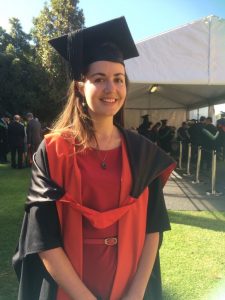 Melanie is a diligent and compassionate scientist. It is reassuring to know that research in a sensitive area such as this, is taking place under the guise of a rational scientist, working for society, and with a solid ethical and moral foundation. I asked Melanie what she would most like to be remembered for, and her response was well in line with her attitude to science.
Melanie is a diligent and compassionate scientist. It is reassuring to know that research in a sensitive area such as this, is taking place under the guise of a rational scientist, working for society, and with a solid ethical and moral foundation. I asked Melanie what she would most like to be remembered for, and her response was well in line with her attitude to science.
“I suppose as someone who, whatever they did, they did it with integrity. And also, someone who really tried to bring a bit more kindness and empathy, especially into science, which does not have a whole lot of that. That would be really nice. I am working on that.”
Written by Don Sinclair
Images Supplied by Melanie Laird


